Restaurants
Sinkles
I posted a few days ago about the International Association of People Who Dine Over the Kitchen Sink, aka 'Sinkies'.And then yesterday, by chance, I came across this Portlandia sketch about Sinkles, the restaurant for people who dine over the kitchen sink.
Posted By: Alex - Sat Dec 04, 2021 -
Comments (1)
Category: Humor, Restaurants
Capt. Hinman’s Floating Restaurant
Captain Sidney Hinman demonstrating a life suit of his own design.
"Capt. Sidney Hinman, Coney Island Life Guard, eating a midday repast cooked by himself on a raft table he constructed standing in eighteen feet of water while encased in his non-sinkable life-saving suit." Brooklyn Standard Union - Apr 20, 1921

"Demonstrating his safety suit — Capt. Sidney Hinman of the Coney Island life saving guards, recently paddled his way down the Hudson River in a suit designed to keep a person afloat. He paddled along for an hour." Regina Leader-Post - Mar 28, 1922
Posted By: Alex - Mon Mar 15, 2021 -
Comments (6)
Category: Restaurants, 1920s
Baitinger’s Automatic Eater
I posted last week about a 1940's invention which envisioned putting restaurant diners on a conveyor belt so that they could be carried past food stations. Several readers commented that the Japanese have embraced the opposite concept, of putting the food on a conveyor belt so that it travels past the diners.I did some research and discovered that the origin of the idea of having food on a conveyor belt traces all the way back to 1919 when John Moses Baitinger of Minnesota applied for a patent on this concept, which he called his "Automatic Eater". His patent was granted in 1923. He had small wooden cars, laden with food and drinks, moving along tracks, pulled by a system of cables.


Karal Ann Marling discusses some of the history of Baitinger's invention in her book Blue Ribbon: A Social and Pictorial History of the Minnesota State Fair:
The ensemble was the invention of the Reverend J.M. Baitinger, an Evangelic churchman, who stationed himself out in front with a megaphone to ballyhoo a new era in state fair dining: "Haba! Haba! Haba! This is the place to be merry. Eat! Eat! Eat! All you want for 50 cents; for without a full stomach you cannot enjoy the fair. Haba! Haba! Haba!"
The Automatic Eater cost Baitinger more than one thousand dollars to build but, because of its novelty and the economies it permitted, the cafe more than paid for itself during a trial run conducted on the last few days of the 1920 fair. "Through the medium of the Automatic Eater," he stated the following summer, "I do away with all excess help and employ only one cook, a dish washer, and a woman to keep the train well stocked with food. I pay no attention to what my customers eat, how long they stay or how much food they consume." But there were healthy profits, which Baitinger turned over to a St. Paul hospital.
Baitinger's Eater was, in many ways, a perfect expression of the mentality of the automation-mad 1920s, obsessed with speed, technology, and efficiency. There were minor drawbacks to the system, however. Diners seated near the end of the line sometimes found that the only cargo left for the eating was boiled cabbage.

Posted By: Alex - Sun Feb 28, 2021 -
Comments (2)
Category: Food, Inventions, Patents, Restaurants, 1910s
The Mechanized Restaurant
British inventor Thomas Maldwyn Lewis and his partners apparently had some expertise in conveyor-belt technology. So they cast about for novel ways to apply this knowledge. What they came up with was the "mechanized restaurant". Their idea was to put diners on a conveyor belt and move them past serving stations. From their 1948 patent:

The inventors argued that this mechanization of the dining experience would "expedite the delivery of meals and enable more meals to be served with the use of a given floor area than is at present possible."
That may be true, but I doubt many restaurant owners would want to invest the money to build one of these, just for the sake of potentially serving a few more meals.
Not to mention the problem of slow eaters. I'm imagining a crowd of diners standing at the end of the conveyor belt, plates in hand, trying to finish their meals.
Posted By: Alex - Sun Feb 21, 2021 -
Comments (2)
Category: Restaurants, Technology, Patents, 1940s
Parking Garage Dining
A sign of the times: Searching for ways to allow more distance between diners, the Glendale Galleria mall in SoCal decided to open an eating area in the parking garage.It definitely has a certain ambiance.
More info: NBC LA, twitter


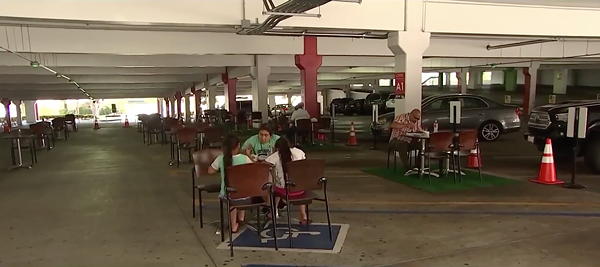
Posted By: Alex - Sat Aug 01, 2020 -
Comments (3)
Category: Restaurants
Edmund Love and His Restaurant Quest
In 1964, THE SATURDAY EVENING POST profiled Edmund G. Love, who intended to eat his way through approximately 5000 NYC restaurants.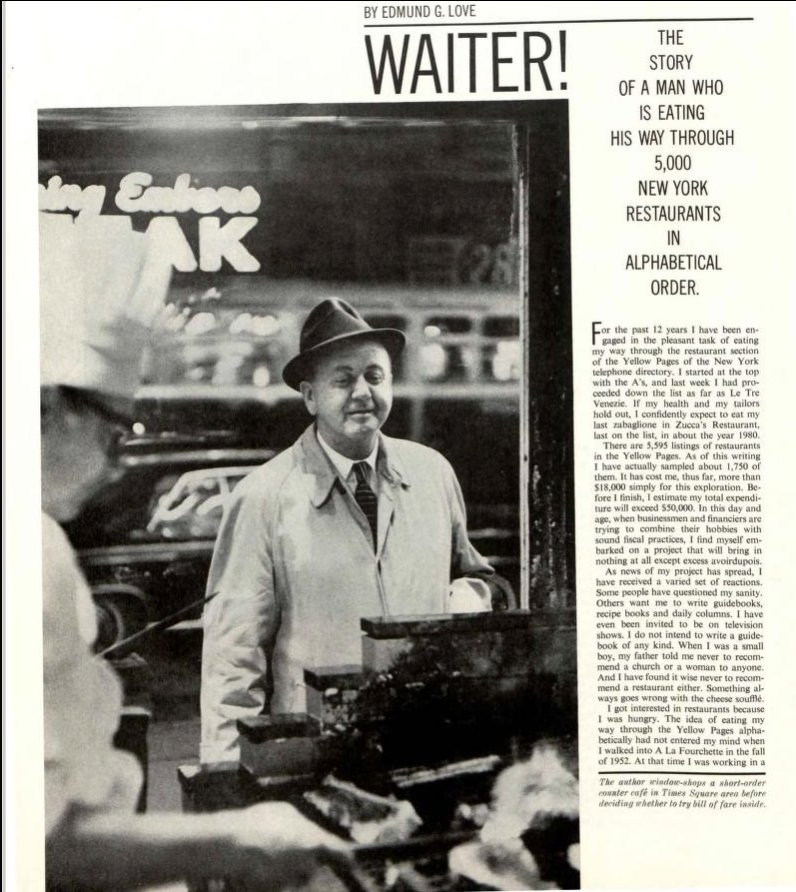

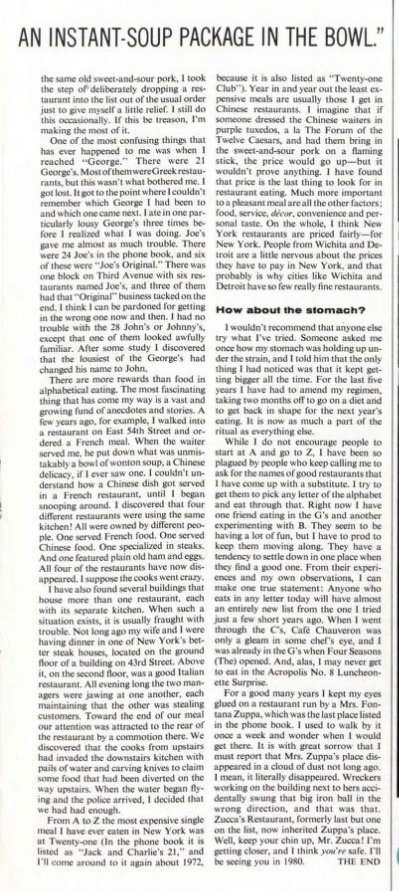
By 1973, when THE NEW YORK TIMES took notice, his quest had ballooned to 6000.

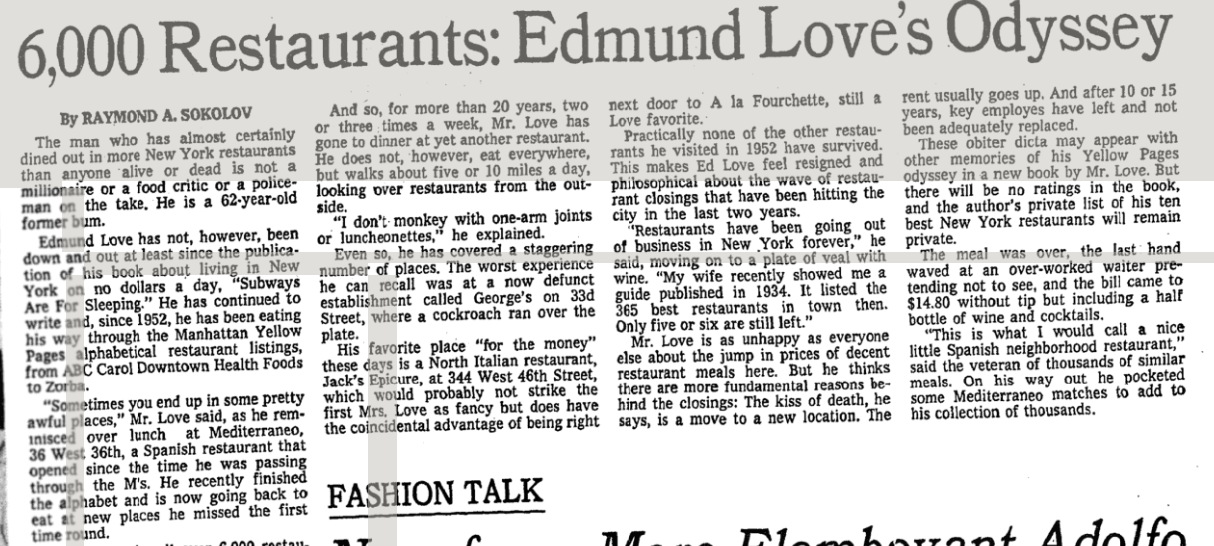
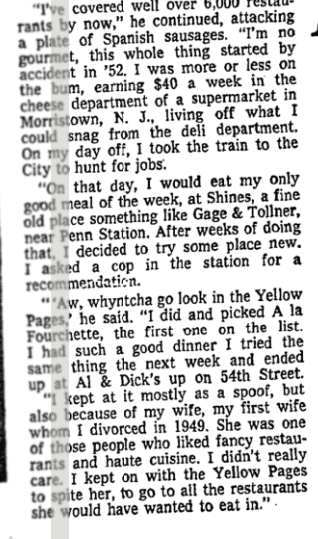
His 1990 obituary in the NYT says he managed to hit 1750 of them.

Posted By: Paul - Thu Nov 07, 2019 -
Comments (4)
Category: Addictions, Bums, Hobos, Tramps, Beggars, Panhandlers and Other Streetpeople, Eccentrics, Food, Restaurants, World Records, Twentieth Century
Open Concept Bar
The Open Concept bar, recently opened in St. Louis, Missouri, doesn’t sell drinks. Instead, it sells time. Buy an hour’s worth of time at the bar, and you can drink as much as you want in that hour. The price is $10/hour for basic drinks, $20/hour for premium ones.Sounds like a bargain! But how does the bar plan to make money? Well, it turns out there actually are some limits to how much alcohol they'll serve you. From St. Louis magazine:
In other words, you can't actually have all you can drink in an hour. But what's the limit? It seems like they're being coy about that. I'm guessing it's about two drinks per hour. So, in essence, you're pre-paying for two drinks.

Posted By: Alex - Wed Oct 09, 2019 -
Comments (5)
Category: Inebriation and Intoxicants, Restaurants, Alcohol
Old Cawlija
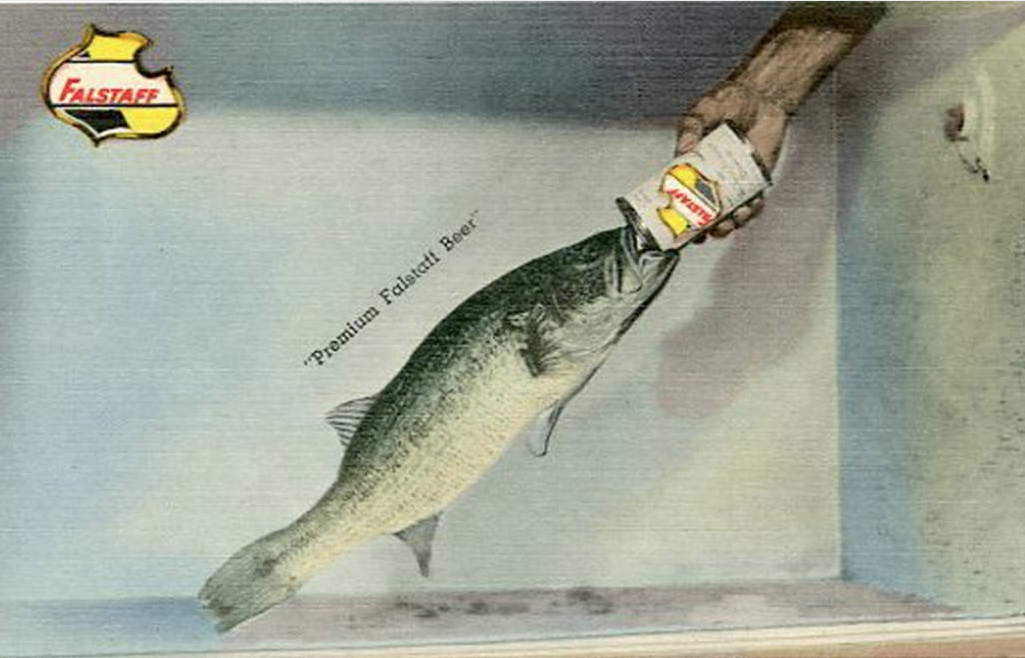
Info at source: "Old Cawlija, a five pound black bass, eats from hand and drinks Falstaff Beer from the can. The tank is placed in front of the Didda-Wa Restaurant."
Posted By: Paul - Sun Apr 08, 2018 -
Comments (1)
Category: Regionalism, Restaurants, Fish, 1950s, Alcohol
The McRazor
Disposable razors were first introduced in 1974, by Bic. In 1976, Gillette came out with its own competing product, the Good News twin blade disposable. And in 1978 McDonald's decided to run a promotion in which they gave away free Gillette Good News razors with orders of breakfast meals.They must have thought the promotion was fairly successful, because it seems that they repeated the offer a couple of times throughout the 1980s. I can't imagine them giving away free razors today.

Honolulu Star Bulletin - Apr 17, 1978
Posted By: Alex - Tue Feb 27, 2018 -
Comments (3)
Category: Restaurants, 1970s
Crazy Cafe
Posted By: Paul - Tue Oct 10, 2017 -
Comments (1)
Category: Entertainment, Restaurants, 1950s

| Who We Are |
|---|
| Alex Boese Alex is the creator and curator of the Museum of Hoaxes. He's also the author of various weird, non-fiction, science-themed books such as Elephants on Acid and Psychedelic Apes. Paul Di Filippo Paul has been paid to put weird ideas into fictional form for over thirty years, in his career as a noted science fiction writer. He has recently begun blogging on many curious topics with three fellow writers at The Inferior 4+1. Contact Us |




